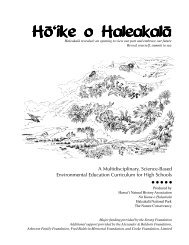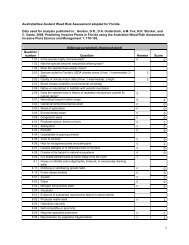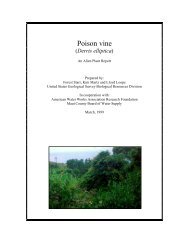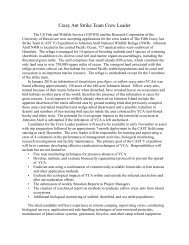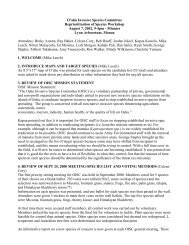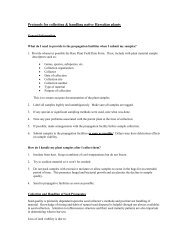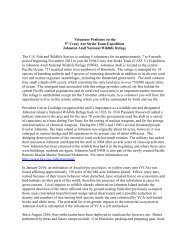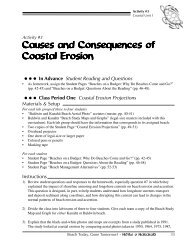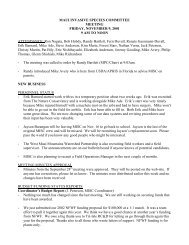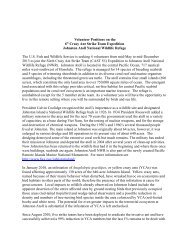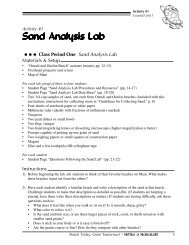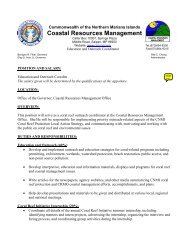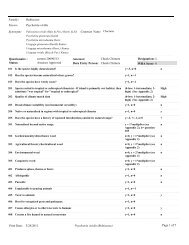Report to the Republic of Palau: 2008 update on Invasive Plant ...
Report to the Republic of Palau: 2008 update on Invasive Plant ...
Report to the Republic of Palau: 2008 update on Invasive Plant ...
You also want an ePaper? Increase the reach of your titles
YUMPU automatically turns print PDFs into web optimized ePapers that Google loves.
• Adenan<str<strong>on</strong>g>the</str<strong>on</strong>g>ra pav<strong>on</strong>ina (telengtúngd, telentundalel, coral bean tree) is a serious problem <strong>on</strong><br />
many Pacific islands. It is present <strong>on</strong> Babeldaob, Koror, Malakal and Ngerkebesang. While<br />
<str<strong>on</strong>g>the</str<strong>on</strong>g> tree appears <str<strong>on</strong>g>to</str<strong>on</strong>g> be fairly comm<strong>on</strong>, it is difficult <str<strong>on</strong>g>to</str<strong>on</strong>g> assess <str<strong>on</strong>g>the</str<strong>on</strong>g> prospective threat <str<strong>on</strong>g>to</str<strong>on</strong>g> <str<strong>on</strong>g>Palau</str<strong>on</strong>g>’s<br />
forests. The extent <str<strong>on</strong>g>of</str<strong>on</strong>g> <str<strong>on</strong>g>the</str<strong>on</strong>g> tree should be mapped, <str<strong>on</strong>g>the</str<strong>on</strong>g> amount <str<strong>on</strong>g>of</str<strong>on</strong>g> reproducti<strong>on</strong> assessed, and a<br />
plan developed for <str<strong>on</strong>g>the</str<strong>on</strong>g> appropriate management <str<strong>on</strong>g>of</str<strong>on</strong>g> this species. The tree should be excluded<br />
from those islands where it is not present and promptly eradicated if found. Infestati<strong>on</strong>s <str<strong>on</strong>g>of</str<strong>on</strong>g><br />
this tree are known <str<strong>on</strong>g>to</str<strong>on</strong>g> be spreading <strong>on</strong> two <str<strong>on</strong>g>of</str<strong>on</strong>g> <str<strong>on</strong>g>the</str<strong>on</strong>g> Rock Islands (not visited during this<br />
survey). A plan <str<strong>on</strong>g>to</str<strong>on</strong>g> eradicate <str<strong>on</strong>g>the</str<strong>on</strong>g>se infestati<strong>on</strong>s was developed in 2006, in cooperati<strong>on</strong> with<br />
Koror State’s Rock Islands C<strong>on</strong>servati<strong>on</strong> Area, but has not been implemented. This plan<br />
should be funded and implemented as so<strong>on</strong> as possible.<br />
• Since few examples <str<strong>on</strong>g>of</str<strong>on</strong>g> Asparagus densiflorus (asparagus fern) are present in <str<strong>on</strong>g>Palau</str<strong>on</strong>g>, all in<br />
cultivati<strong>on</strong>, <str<strong>on</strong>g>the</str<strong>on</strong>g>y could easily be eradicated. Future imports <str<strong>on</strong>g>of</str<strong>on</strong>g> this and closely related species<br />
should be prohibited <strong>on</strong>ce <str<strong>on</strong>g>the</str<strong>on</strong>g> resident populati<strong>on</strong> is eradicated.<br />
• Calamus sp. (bangerenguis ra ngebard, rattan) is known from two locati<strong>on</strong>s al<strong>on</strong>g <str<strong>on</strong>g>the</str<strong>on</strong>g><br />
roadside in Aimeliik State and is reproducing quite well. It could spread elsewhere, and<br />
makes travel where it is present very unpleasant. It appears <str<strong>on</strong>g>to</str<strong>on</strong>g> occupy less than five acres.<br />
The infestati<strong>on</strong> should be mapped and, if feasible, proposed for eradicati<strong>on</strong>. This species is<br />
invasive and is undergoing eradicati<strong>on</strong> in Samoa.<br />
• Casuarina equisetifolia (ngas, casuarina, ir<strong>on</strong>wood, Australian pine), although thought <str<strong>on</strong>g>to</str<strong>on</strong>g> be<br />
native <strong>on</strong> most islands in <str<strong>on</strong>g>Palau</str<strong>on</strong>g>, should be eradicated <strong>on</strong> Tobi and Helen’s Reef and excluded<br />
from S<strong>on</strong>sorol, o<str<strong>on</strong>g>the</str<strong>on</strong>g>r islands <str<strong>on</strong>g>of</str<strong>on</strong>g> S<strong>on</strong>sorol State and any locati<strong>on</strong>s where sea turtles nest.<br />
• One <str<strong>on</strong>g>of</str<strong>on</strong>g> <str<strong>on</strong>g>the</str<strong>on</strong>g> bioc<strong>on</strong>trol agents for Chromolaena odorata (ngesngesil, chromolaena, Siam<br />
weed), Cecidochares c<strong>on</strong>nexa, has been successfully introduced <str<strong>on</strong>g>to</str<strong>on</strong>g> <str<strong>on</strong>g>Palau</str<strong>on</strong>g> and is present in<br />
most areas <str<strong>on</strong>g>of</str<strong>on</strong>g> Babeldaob and Koror State. However, <str<strong>on</strong>g>the</str<strong>on</strong>g>re are a few sites where galls were<br />
not observed and <str<strong>on</strong>g>the</str<strong>on</strong>g> agent may not be established. Apparently it may not be established <strong>on</strong><br />
<str<strong>on</strong>g>the</str<strong>on</strong>g> islands <str<strong>on</strong>g>of</str<strong>on</strong>g> Peleliu and Angaur. The agent should be introduced <str<strong>on</strong>g>to</str<strong>on</strong>g> <str<strong>on</strong>g>the</str<strong>on</strong>g>se two islands and<br />
reintroduced in areas where it is not established. Ano<str<strong>on</strong>g>the</str<strong>on</strong>g>r attempt should probably be made<br />
<str<strong>on</strong>g>to</str<strong>on</strong>g> introduce Pareuchaetes pseudoinsulata as well as any new agents that might be<br />
appropriate. Semi-annual visits <str<strong>on</strong>g>to</str<strong>on</strong>g> pull new plants <strong>on</strong> Ngidech Island should be c<strong>on</strong>tinued<br />
until this infestati<strong>on</strong> is eliminated.<br />
• If it is still <str<strong>on</strong>g>the</str<strong>on</strong>g>re, <str<strong>on</strong>g>the</str<strong>on</strong>g> single specimen <str<strong>on</strong>g>of</str<strong>on</strong>g> Clerodendrum quadriloculare (kleuang, br<strong>on</strong>zeleaved<br />
clerodendrum) found in 2002 <strong>on</strong> Ngercheu Island (Carp Resort) should be removed<br />
(not seen in <str<strong>on</strong>g>2008</str<strong>on</strong>g>). This species is not comm<strong>on</strong> <strong>on</strong> Peleliu and Angaur and should be<br />
mapped and evaluated for eradicati<strong>on</strong> <str<strong>on</strong>g>the</str<strong>on</strong>g>re. Infestati<strong>on</strong>s <strong>on</strong> o<str<strong>on</strong>g>the</str<strong>on</strong>g>r islands should be mapped<br />
<str<strong>on</strong>g>to</str<strong>on</strong>g> determine <str<strong>on</strong>g>the</str<strong>on</strong>g> area still infested. C<strong>on</strong>trol <str<strong>on</strong>g>of</str<strong>on</strong>g> infestati<strong>on</strong>s impacting natural ecosystems<br />
should be c<strong>on</strong>tinued as well as assistance <str<strong>on</strong>g>to</str<strong>on</strong>g> landowners in c<strong>on</strong>trolling this undesirable<br />
species.<br />
• A single plant <str<strong>on</strong>g>of</str<strong>on</strong>g> Clidemia hirta (kúi, Koster’s curse) was found <strong>on</strong> Malakal during <str<strong>on</strong>g>the</str<strong>on</strong>g> 2002<br />
survey and was eliminated. No new plants were found <strong>on</strong> Malakal during this survey. The<br />
main infestati<strong>on</strong> is in <str<strong>on</strong>g>the</str<strong>on</strong>g> Nekken area <str<strong>on</strong>g>of</str<strong>on</strong>g> central Babeldaob and around old Oikull village.<br />
43



